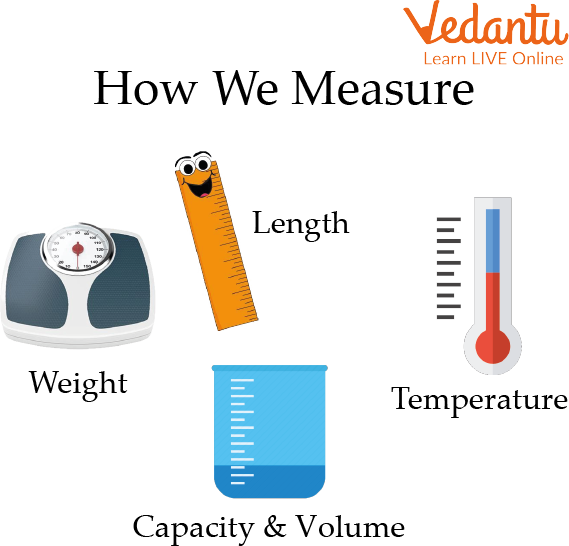




Key Concepts and Real-Life Examples Explained
This article mainly presents a brief description of Temperature, Capacity, Weight and Mass, which we see in our daily life. It is also used in some way or the other in our daily work, children need to know about it. Some of these things have been taken care of in this article, we are going to discuss some definitions related to it and the mass and weight difference, along with vital capacity and units to measure capacity. Also, examples and worksheets related to them have been given, which makes it easier to understand. Taking this sequence forward, we try to understand this article.

Units to Measure Capacity
Difference Between Mass and Weight
Here the mass and weight differences are explained:

Different Units of Measurement
Vital Capacity
When anything is referred to as vital, it denotes that it is necessary or extremely significant. The total amount of air that can be expended from the lungs with the greatest amount of exertion is known as the vital capacity(VC). It enables simultaneous inhalation of the greatest possible volume of clean air and exhalation of the greatest possible volume of stale air. So, by increasing gaseous exchange between the body's various tissues, it improves the amount of energy available for bodily function.
Units to Measure Capacity
Any container's capacity refers to the volume of liquid it can hold. The United States Customary Units is another name for the American metric system (USCS). USGS measures the capacity using 5 standardized units. A liquid's volume is expressed using the phrase capacity. Other units that are multiples and submultiples of litres are also used to measure big and tiny quantities. The larger and more compact units that are connected to litres are shown in the following table:
Temperature, Capacity, Weight and Mass Related Solved Examples
Here are some questions mainly related to the conversion of units, which are like this;
Example 1. Convert 300 kilometres in meters.
Solution: We know that 1 km = 1000 m
So, 1 km ×100= 100 kilometres
Putting the value of 1km = 1000 m
100 km = 1000 m × 100
= 100000m
So, 300 km = 300000 m.
Therefore, 300 km equals 300000 m.
Example 2. Convert 45 degree Celsius to Fahrenheit?
Solution- Given us, Temperature = 45 degree Celsius
We know that,
F = 9/5 X C + 32
F = 9/5 X 45 + 32
F= 9 X 5 + 32
F= 45 + 32
F= 77 ° F
Therefore, 45-degree celsius equals 77 degrees Fahrenheit.
Example 3. 7 kilograms is equal to how many grams?
Solution- Given us, 7 kilograms is changed into grams.
We know that,
1 kilogram = 1000 gram
So,
7 kilograms = 7 X 1000 gram
7 kilograms = 7000 gram
Therefore, 7 kg equals 7000 g.
Practice Problems
Here are some practice problems to be solved by the students themselves:
1. Convert 65 degree Celsius to Fahrenheit?
Ans. 149 ° F.
2. 41 kilograms is equal to how many grams?
Ans. 41000 gms.
3. Convert 3 kilometres in meters.
Ans. 3000 m.
4. Convert 77⁰ Fahrenheit to Celsius?
Ans. 25 degrees Celsius.
Summary
Capacity, Weight/Mass, and Temperature are the three main factors that affect one's life. It enables kids to precisely and properly estimates the object's dimensions. Additionally, it makes determining an object's size interesting and engaging for learning about the issue at hand. Here, children have learned about the difference between mass and weight along with vital capacity and units to measure capacity. This article has been made keeping these few things in mind, where not only examples related to the conversion of units have been given but practice problems related to them have also been presented, which play a major role in the development of children.
FAQs on Units of Measurement for Temperature, Capacity, Weight & Mass
1. What is temperature and how is it measured?
Temperature tells us how hot or cold an object is. It is commonly measured in degrees Celsius (°C) or degrees Fahrenheit (°F). For instance, we use a thermometer to check our body temperature or to know the temperature of the day.
2. What do 'capacity' and 'weight' mean in mathematics?
In mathematics, these terms refer to specific types of measurement:
- Capacity is the amount a container can hold, like the amount of water in a bottle. It is measured in litres (L) and millilitres (mL).
- Weight is a measure of how heavy an object is. It is measured in grams (g) and kilograms (kg).
3. What is the main difference between mass and weight?
The main difference is that mass is the amount of matter or 'stuff' inside an object, and it never changes. Weight is the force of gravity pulling on that mass. While on Earth they seem similar, an astronaut has the same mass on Earth and in space, but is weightless in space due to the lack of gravity.
4. How do capacity and volume differ?
Capacity refers to the maximum amount a container can hold, and it is typically used for liquids (e.g., a jug has a 1-litre capacity). Volume refers to the three-dimensional space an object occupies (e.g., the volume of a solid brick). While related, capacity is about holding, and volume is about occupying space.
5. What are the standard units for measuring mass and capacity?
The standard units of measurement as per the NCERT syllabus are:
- For Mass/Weight: The basic unit is the gram (g). A larger unit is the kilogram (kg), where 1 kg = 1000 g.
- For Capacity: The basic unit is the litre (L). A smaller unit is the millilitre (mL), where 1 L = 1000 mL.
6. What instruments are used to measure weight, capacity, and temperature?
Different instruments are used for each measurement:
- Weight: A weighing scale or balance is used to measure how heavy an object is.
- Capacity: Measuring cups, beakers, or graduated cylinders are used to measure the amount of liquid a container can hold.
- Temperature: A thermometer is used to measure how hot or cold something is.
7. Why are standard units like kilograms and litres important in daily life?
Standard units are crucial because they provide a consistent and universal form of measurement. If a shopkeeper used their hands to measure rice, everyone would get a different amount. Using standard units like a kilogram ensures that everyone, everywhere, gets the exact same quantity, making trade and science fair and accurate.
8. Provide some real-world examples of measuring temperature, capacity, and weight.
We use these measurements every day. For example:
- Temperature: Checking the weather forecast to see if it will be a hot or cold day.
- Capacity: Buying a 2-litre bottle of juice or using a 250 mL cup of milk for a recipe.
- Weight: Buying 1 kg of apples from a fruit seller or measuring your own body weight on a scale.
9. How are the measurements of capacity and weight connected for a substance like water?
For water, there is a very convenient connection between capacity and weight. A container with a capacity of 1 litre (L) can hold 1 litre of water. This amount of water has a weight (and mass) of approximately 1 kilogram (kg). Similarly, 1 mL of water weighs about 1 g. This simple relationship is very useful in science and everyday calculations.























